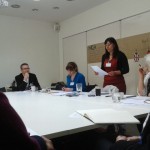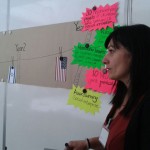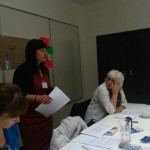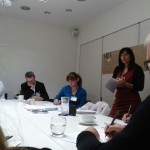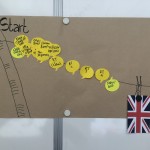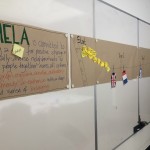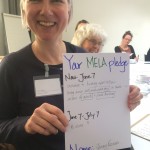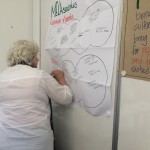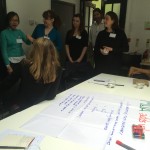As another awful, avoidable tragedy unfolds on the seas between North Africa and Fortress Europe and another round of gratuitous political rhetoric captures the headlines, another day goes by when we as a society fail to address the other, longer term question. That question being: given the inevitably of an ever more mobile and diverse world, how can we learn to live together in productive harmony?
Sadly, it seems to me that even outside of the febrile atmosphere of the current refugee crisis we have consistently failed to focus our minds on what it means to make superdiversity work on a practical day-to-day basis. The reasons are not too hard to find. For many, merely having a discussion about how to manage a situation is tantamount to accepting that situation as the new reality – yet large sections of our political class, media and public are still in denial that our society is irrevocably diverse. For them the answers are brutally simple: close the borders to newcomers and oblige existing minorities to assimilate into the ways of the majority. But let’s put that on one side for the moment and address another kind of myopia – that of the liberal who accepts the inevitability of a diverse society yet assumes that if we all simply try to get along, things will somehow turn out fine in the end.
Things may well turn out fine, but I’m a big believer in giving them a helping hand through public policy. In other words, we need to help give people reasons and incentives to prefer cultural encounter to avoidance, and for this we need to create tools, institutions and spaces of interaction. This is much easier said than done, but the rewards make the effort worthwhile. That’s because heterogeneity is superior to homogeneity and throughout history cities and civilisations have thrived on the social, cultural and economic innovations it has thrown up. But, if we want to achieve the diversity advantage, rather than a deficit, for our cities we have to actively work for it.
There are many arenas in which to seek productive encounter and interaction. The most important are in education, the workplace and civil society – but I want to highlight another, public space. As Jane Jacobs said:
“Dull, inert cities, it is true, do contain the seeds of their own destruction and little else. But lively, diverse, intense cities contain the seeds of their own regeneration, with energy enough to carry over for problems and needs outside themselves.”
“Cities have the capability of providing something for everybody, only because, and only when, they are created by everybody.”
Too often though the place-making professions, when asked what they can contribute, have held up their hands and claimed that cultural diversity is outside of their remit. But Leonie Sandercock has thrown down a challenge
“We are seeing the death of the Rational City and its replacement by Cosmopolis – the city of difference. We need an expanded language to express the city of memory, the city of desire and the city of the spirit. We need a new epistemology of planning.”
To be honest, architecture, planning, urban design and public space management are not going to make the decisive difference in determining whether a city is nasty, brutish and segregated or open and intercultural – but this does not let them off the hook. We now have ample evidence to show that good public space enhances the lives of communities and individuals, and that bad or neglected spaces can aggravate underlying socio-economic tensions and injustices.
I tried to arouse a new spirit of intervention in my book The Intercultural City: Planning for Diversity Advantage (2008) and since them, I have been working with the Council of Europe’s Intercultural Cities project to put ideas into action. Within a growing network of over 60 cities, we have engaged with place-making professionals to evolve practical guidelines and tools which can be used in a variety of environments, see http://www.coe.int/interculturalcities.
For example, the Intercultural Plan of the city of Barcelona, using a language and a conceptual grasp rarely seen in such documents, talks of finding “a renewed definition of the public space – spaces for relations – as an integral part of the idea of a city and as a space for meeting and generation of citizenship”. The Plan commits the city to a very purposeful set of actions including “incorporating new indicators into the diagnosis of what is really happening on the ground prior to taking action (such as) an in-depth analysis of the socio-cultural reality and the changes and evolutions that occur (and) integrating the perception and knowledge that the different groups and social agents make of their neighbourhood and city as a whole”. It goes on further to commit to “Incorporate into public spaces elements that contribute to generating spontaneous interaction between users: play areas in children’s’ parks, specific offers for young people, bicycle or walking paths”.
The Plan evolved through a very extensive process of conversations inspired by key questions such as “What do you think are the common elements that should be shared by people of different cultural origins in order to live together peacefully in the neighbourhood and in the city?” and “Can you describe any space of interculturality or intercultural coexistence in Barcelona?”
It is, to my mind, the most sophisticated attempt by a city, thus far, to get to grips with these issues and should be a source of inspiration to others stepping tentatively into the field (see http://www.bcn.cat/novaciutadania/pdf/en/PlaBCNInterculturalitatAng170510_en.pdf)
Britain has been a laggard in facing up to these issues, but there is good practice, for example in the London Borough of Lewisham. Waking up to the danger that it was becoming a dormitory for disengaged and atomised commuters, with an unfriendly and degraded public realm, Lewisham has taken effective action on a range of fronts over the last decade.
Following a widespread listening exercise, a toolkit for intercultural place-making was produced and this informed a new approach to public space in Lewisham. A programme of targeted improvement has transformed numerous locations within the district – and Lewisham’s commitment has aroused widespread recognition and approbation. Four of the Borough’s public spaces have received prizes in the London Planning Awards in the last few years: Ladywell Fields, Deptford Lounge, Cornmill Gardens and Margaret McMillan Park. The Park was also awarded first place in the Urban Green Space Category of the Local Government News 2011 Street Design Awards, and the Civic Trust Award in 2010 for Community Recognition.
The Metropolitan Police crime statistics for Lewisham suggest that the Borough’s approach may be paying dividends and, in a survey conducted by the Council, 78% of local residents said they now use the park more, whilst 93% said they felt safer.
Lewisham has also sought to animate its public spaces, organising ‘Big Lunch’ Street Parties in residential streets as well as several larger ‘Big Conversation’ events in which strangers from across the borough are encouraged to make new contacts over a meal, in association with the philosopher Theodore Zeldin. The Borough’s approach to intercultural place-making is described in a short video at https://youtu.be/NfNXaShIg3Y.
So, to conclude, it now seems to me that the emergence of MELA Social Enterprise is very timely, bringing a much-needed focus upon the oft-overlooked skills and insights of intercultural place-making. There’s much to be done.

